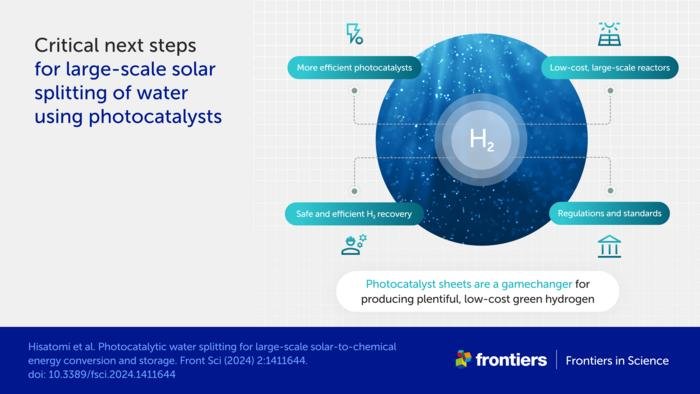Eddie Gonzales Jr. – MessageToEagle.com – Technological advances may enable us to use sunlight to split water into hydrogen and oxygen, providing renewable fuel.
Critical next steps for large-scale solar splitting of water using photocatalysts. Image: Hisatomi et al/Frontiers
In the future, we could fuel the world with sunlight and water – using sunlight to derive hydrogen fuel from H2O.
Currently, most hydrogen that’s used as feedstock and fuel is derived from natural gas, and therefore doesn’t help us cut out fossil fuels. But Japanese scientists are leading the way towards a future powered by hydrogen, with new, easily-manufactured photocatalytic sheets and a proof-of-concept panel reactor which shows that it is possible to refine hydrogen fuel from water at scale.
“Sunlight-driven water splitting using photocatalysts is an ideal technology for solar-to-chemical energy conversion and storage, and recent developments in photocatalytic materials and systems raise hopes for its realization,” said Prof Kazunari Domen of Shinshu University, senior author of the article in Frontiers in Science. “However, many challenges remain.”
Steam power for the 21st century
To use sunlight to split water into oxygen and hydrogen, we need photocatalysts. Under light, these catalysts promote chemical reactions which split the water. In one-step excitation systems, the photocatalyst breaks water down to hydrogen and oxygen. These systems are simple but inefficient, with a very low solar-to-hydrogen energy conversion rate. More efficient at present are two-step excitation systems, where one photocatalyst evolves hydrogen from water and the other evolves oxygen from water.
“Obviously, solar energy conversion technology cannot operate at night or in bad weather,” said Dr Takashi Hisatomi of Shinshu University, first author of the study. “But by storing the energy of sunlight as the chemical energy of fuel materials, it is possible to use the energy anytime and anywhere.”
These systems have a higher solar-to-hydrogen energy conversion rate – but they’re not yet ready for use. We need to identify the most effective and sustainable photocatalysts, which must be robust enough to tolerate daily start-up and shut-down operations as the sun rises and sets. We also need to increase the efficiency of the conversion as much as possible, to minimize the amount of physical space needed for a reactor and make the reactor cost-effective to run – right now, using natural gas to refine hydrogen fuel is still cheaper.
However, many methods of splitting oxygen and hydrogen produce oxyhydrogen, which is highly explosive. This risk can be eliminated by producing oxygen and the hydrogen separately, or managed by using design criteria identified by Domen and Hisatomi’s team.
By experimenting with oxyhydrogen, they determined that if the gas is ignited in a small, narrow compartment, it does not explode. Materials are also important: soft PVC plastic does not explode destructively if oxyhydrogen ignites.
The future of fuel
Domen and Hisatomi’s team have already produced a successful proof of concept, running a 100m2 reactor for three years. This reactor even performed better faced with real-world sunlight than it did in under laboratory conditions.
“In our system, using an ultraviolet-responsive photocatalyst, the solar energy conversion efficiency was about one and a half times higher under natural sunlight,” said Hisatomi. “Simulated standard sunlight uses a spectrum from a slightly high latitude region. In an area where natural sunlight has more short-wavelength components than simulated reference sunlight, the solar energy conversion efficiency could be higher. However, currently the efficiency under simulated standard sunlight is 1% at best, and it will not reach 5% efficiency under natural sunlight.”
To move the technology forward and break that 5% barrier, the team says that more researchers need to develop more efficient photocatalysts and build larger experimental reactors. More real-world experiments are needed to develop the technology to the point where hydrogen is a feasible fuel option.
Safety regulations and efficiency standards are important. An accreditation body and licensing ensure safe technology development, while standardized methods identify effective systems.
“The most important aspect to develop is the efficiency of solar-to-chemical energy conversion by photocatalysts,” explained Domen. “If it is improved to a practical level, many researchers will work seriously on the development of mass production technology and gas separation processes, as well as large-scale plant construction. This will also change the way many people, including policymakers, think about solar energy conversion, and accelerate the development of infrastructure, laws, and regulations related to solar fuels.”
Written by Eddie Gonzales Jr. – MessageToEagle.com Staff Writer







